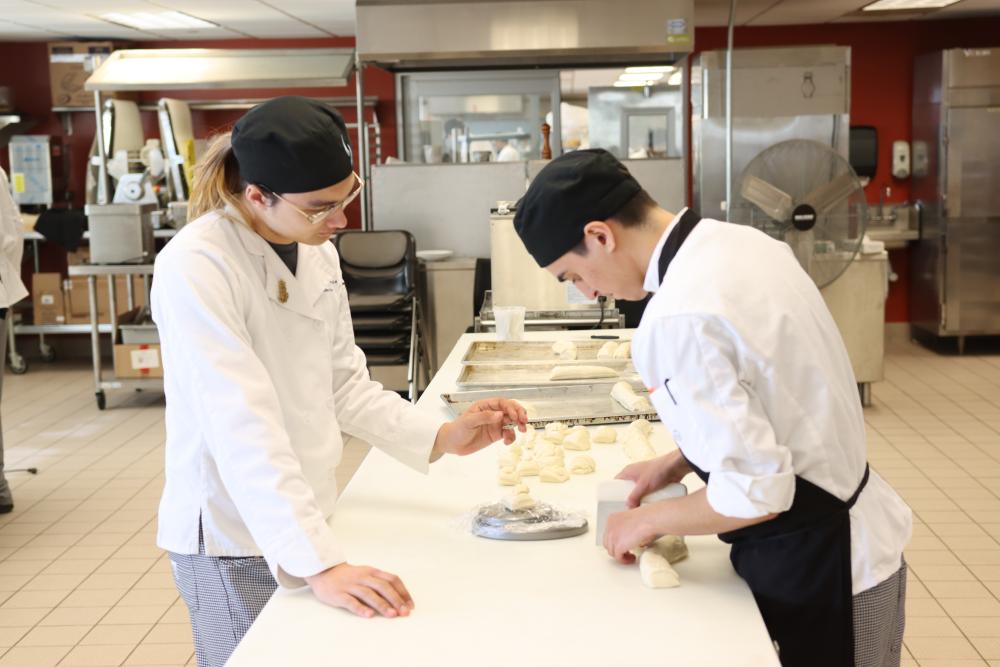
Chefs in the Classroom: Preparing Kitchen Coalition Meals at Saint Paul College
“238. Every other number is dictated by 238.”
I am not a chef. I have a few dishes that I can make with confidence. I can follow a recipe relatively well, but inevitably forget the order of operations and hope that everything turns out okay. I am a proud two-time Tuscaloosa Chili Cook-Off winner. But right now, as I stand in the back of Chef Jason Ross’ Contemporary Cuisine classroom at Saint Paul College, I realize that I am entirely out of my element.
As one would expect, a food service practicum course is not held in a standard classroom. Instead, Chef Jason’s classroom is a full-service kitchen, complete with a massive array of pots, pans, mixers, and other types of cooking equipment. Chef Jason’s cohort of 17 students don’t resemble your classic college students at first either: instead, they are dressed in their white coats and black caps, trading in their writing utensils for chef’s knives and dough cutters.
In this course, students explore various aspects of food production in a fast-paced, high-volume food service setting. Most students are in their second semester of culinary arts studies, with a few courses in culinary foundations underneath their belt. Despite being at the relative beginnings of their culinary education at Saint Paul College, many students have worked in commercial kitchens, and most of them have had a life-long love of cooking and food.
238. The number of pieces of chicken available. Which means 238 meals need to be made, packaged in a Kitchen Coalition-branded container, and distributed here on campus through the Saint Paul College Food Pantry to students, staff, and community members.
From this number, Chef Jason composes not only a menu, but the amount of each ingredient needed to divide into 238 serving-sized portions of food. Chef Jason decides on a meal consisting of fried chicken, mashed potatoes and gravy, coleslaw, and a dinner roll.
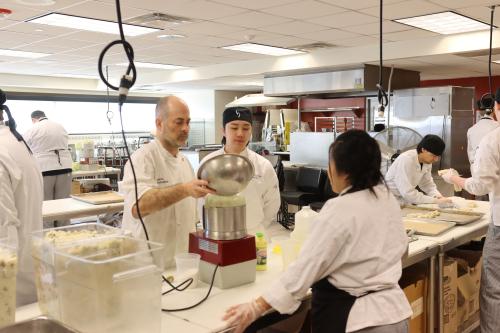
Chef Jason assists students in making mayonnaise dressing from scratch.
Each class begins with a brief lecture, talking about plans for the day as well as setting up the working space for the highest level of success. A few of the ingredients of the meal, including the mashed potatoes and gravy were prepared in a previous class session, but still need to be divided into portions. Every aspect of the meal is truly made-from-scratch: the cabbage needs to be shredded for the coleslaw. The dough for the bread needs to proof. Even the mayonnaise for the coleslaw needs to be mixed.
“When you’re making this type of mayo, you want to make it fluffy and a little less eggy,” Chef Jason tells his students. “French style has more egg, but as a dressing you want it a little thinner.”
Chef Jason reminds his students of a phrase that any amateur chef—or at least anyone who has watched a cooking competition show—would find familiar: acid and fat.
“A little bit of citrus. A little bit of salt—we want that creamy fatty taste. Slow with the oil at first, and then you can add a bit more,” Chef Jason says to his students as they gather around a large mixing bowl.
While some students are on mayo duty, others are fast at work cutting dough and rolling the pieces into balls before they are ready to go into the oven. Others are preparing the coleslaw, chopping up giant heads of cabbage provided by Second Harvest Heartland, and shoving the wedges into a massive food processor.
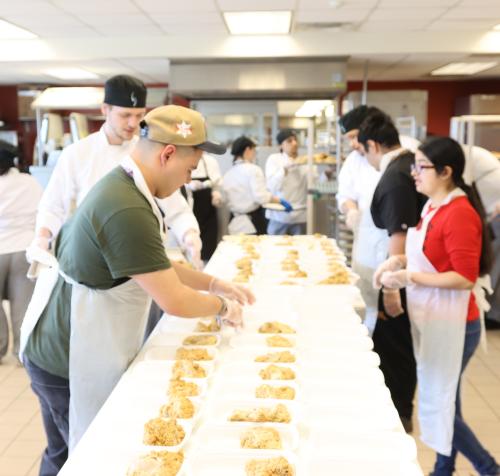
Plating is an important aspect of food preparation. Kitchen Coalition meals are plated with portability and convenience in mind.
As I try my best to stay out of the way of the buzzing operation, I am impressed by the sheer volume of food being prepared—anyone that has cooked for a group of people knows the work that goes into making multiple dishes that all rely on particular timing. For some, preparing a meal for one person is a difficult task—not only because of the time and labor involved, but a lot of people simply do not have the equipment nor the ability. This thought was at the forefront as I realized that all of this work was going into crafting a meal for someone so they didn’t have to worry about these things. I have been fortunate to see first-hand the impact a freshly prepared meal has—from seniors going through radiation treatment who physically cannot stand at a stove for an extended period, to college students who do not have access to a kitchen nor the time to prepare meals for themselves. But this is the first time I saw the physical labor of cooking and preparing these meals: the whirlwind of hot trays filled with freshly baked rolls emerging from the oven, to the students running to the pantry to pick out some extra spices to make sure that the mayonnaise-based dressing has enough flavor to come through when mixed with the cabbage.
“I don’t love a smoked paprika in a dressing because it’s so powerful,” says Chef Jason. The students opt to include some black pepper and a touch of cayenne to punch up the flavor profile, sampling the dressing with small plastic spoons. When it is deemed flavorful enough, they pour the dressing into a large tub filled with fluffy shredded cabbage. One of the students begins mixing the coleslaw together, as the cabbage begins to shrink as it absorbs the creamy dressing.
“We don’t do waste,” says Luka, one of the students in the course. “Then we’d just have to throw stuff away, and that’s just a shame.”
This phrase is at the heart of Kitchen Coalition’s mission: students develop valuable problem-solving and critical thinking skills as they work creatively to craft delicious meals from recovered ingredients. This partnership has blossomed, with Kitchen Coalition being awarded Saint Paul College's 2024 Community Partner of the Year award. “This program’s success is a testament to the dedication of Chef Jason Ross and Joe Kunitz of Second Harvest Heartland’s Kitchen Coalition,” said Chef Sara Johannes, Culinary Arts Faculty at Saint Paul College. “Their commitment to both nourishing our community and providing educational opportunities is truly inspiring.”
Jason’s students not only learn meal preparation skills, but also feed their fellow students. There are even opportunities for these students to weave elements of their own heritage into their culinary creations, fostering a sense of cultural exchange.
“We had a beautiful garden growing up and I realized I had all of these incredible vegetables and I wanted to learn how to cook them,” says Lonny, a student and aspiring chef. “To me, food is so important. I spent some time living out of my car eating ramen. So to be able to eat—to able to make food for myself and others to eat, it’s everything.”
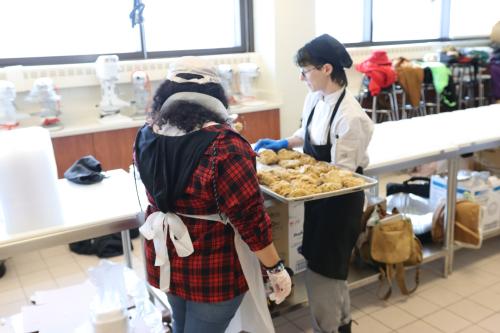
Lonny, a student in the course, assists a member of the Focus Beyond group in arranging fried chicken.
After a short break to allow the dinner rolls to finish baking, Chef Jason’s students begin the process for plating. While most people think of plating as food arranged on an actual physical piece of dishware, food presentation encompasses a multitude of mediums, including Japanese-style bento boxes, and our very own Kitchen Coalition containers. Lonny has painstakingly adhered Kitchen Coalition stickers that contain the ingredients of the meal going out to neighbors: fried chicken, mashed potatoes with gravy, coleslaw, and dinner rolls. Another factor in plating is making sure that a meal is not only presentable, but also practical.
“We’re going to do the mashed potatoes and gravy cafeteria style,” says Chef Jason. “We want to push the ladle into the potatoes so it will hold its shape and not make a mess.”
These are the nuances in plating that make a massive difference in how neighbors receive Kitchen Coalition meals. A common refrain that I’ve heard while interacting with chefs is that they want to make sure that they are serving meals that they would serve to their grandmother—that care and consideration is put into every single one of the 238 meals that are going out the doors of Chef Jason’s classroom.
To assist in the plating of the Kitchen Coalition meals, a group from Focus Beyond Transition Services have arrived in Chef Jason’s classroom. Focus Beyond is a special education program that works with young adults ages 18-22 who have unmet special education needs. The program offers community-based activities and experiences in which students have the opportunity to explore their employment, post-secondary, and independent living skills. Today, this group decided to come to Saint Paul College on their “field trip day” to help fulfill some community service hours and assist in plating.
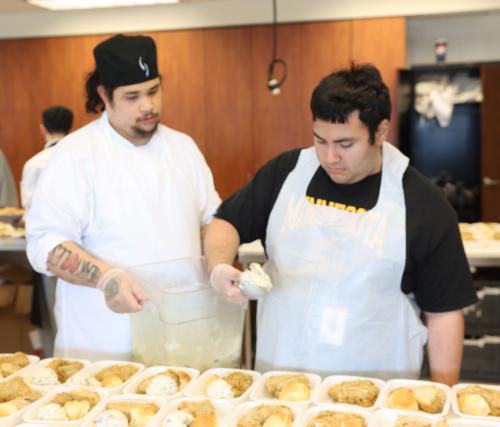
The meals prepared in Chef Jason's course help feed fellow Saint Paul College students.
As a former educator myself, it was really heartening to see Chef Jason’s students take on a new role—quickly pivoting from amateur chefs to seasoned veterans as they assist the Focus Beyond students in plating. They demonstrate the most efficient place to put all of the ingredients, as well as making sure that each of the scoops of potatoes and slaws are equal—“the last thing we want is to get to the last piece of chicken and not have enough gravy,” Chef Jason reminds the class.
As the final pieces of chicken are delicately placed in Kitchen Coalition containers, I make sure to thank Chef Jason and his students for the meals they are helping to provide for their community and fellow students. “Man, that’s really cool,” says Oscar, one of Chef Jason’s students. “It makes sense because if we’re cooking it, people might as well eat it.”
Leaving Chef Jason’s classroom gave me even more of an appreciation for all the work that goes into a Kitchen Coalition meal—the sheer scale of the operation as well as the efficiency and care that goes into planning each stage of the meal preparation and plating process is a wildly impressive undertaking. Seeing the joy that comes from not just preparing food but having the knowledge that what they create in the classroom is making a valuable difference in their community. It is a nourishing endeavor and a collaborative effort that demonstrates that what is learned in the Saint Paul College classroom has an immediate and important impact as we seek to keep our neighbors fed and end hunger for good.
